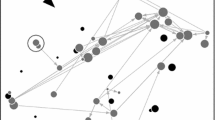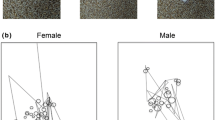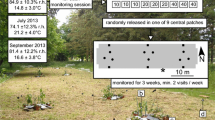Abstract
Individual movement patterns and the effects of host plant patch size and isolation on patch occupancy were examined for red milkweed beetles, Tetraopes tetraophthalmus, residing in a heterogeneous landscape. Male beetles were found to move both more often and farther between host plant patches than female beetles, and this difference affected the patterns of patch occupancy observed. Overall, unoccupied milkweed patches were smaller and more isolated than patches occupied by beetles. Patches uninhabited by females tended to be more isolated, but not necessarily smaller, than patches with female beetles, indicating that females may be affected more by patch isolation than patch size. Presence of male beetles on patches showed a stronger response to patch size than to patch isolation. Differences in movement between males and females illustrate the need for demographically based dispersal data. Comparisons of Tetraopes interpatch movement patterns between landscapes composed of patches of different size revealed that landscapes with overall smaller patches may have greater rates of interpatch movement.
Similar content being viewed by others
References
Bach CE (1988) Effects of host plant patch size on herbivore density: patterns. Ecology 69:1090–1102
Brown JH, Kodric-Brown A (1977) Turnover rates in insular biogeography: effect of immigration on extinction. Ecology 58:445–449
Chemsak JA (1963) Taxonomy and bionomics of the genus Tetraopes (Cerambycidae: Coleoptera) University of California Publications, Berkeley
Cohen J (1977) Statistical power analyses for the behavioral sciences. Academic Press, New York
Connor EF, Faeth SH, Simberloff DS (1983) Leafminers on oak: The role of immigration and in situ reproductive recruitment. Ecology 64:191–204
Davis MA (1981) The flight capacity of dispersing milkweed beetles, Tetraopes tetraophthalmus. Ann Entomol Soc Am 74:385–386
Davis MA (1984) The fight and migration ecology of the red milkweed beetle Tetraopes tetraophthalmus. Ecology 65:230–234
Faeth SH, Simberloff DS (1981) Experimental isolation of oak host plants: effects on mortality, survivorship, and abundances of leaf mining insects. Ecology 62:625–635
Fahrig L, Merriam G (1985) Habitat patch connectivity and population survival. Ecology 66:1762–1768
Fahrig L, Paloheimo J (1988) Determinants of local population size in patchy habitats. Theor Popul Biol 34:194–213
Feller W (1968) An introduction to probability theory and its applications, vol 1, 3rd edn. Wiley, New York
Gaines MS, McClenaghan LR Jr (1980) Dispersal in small mammals. Annu Rev Ecol Syst 11:163–196
Hanski I, Gilpin M (1991) Metapopulation dynamics: brief history and conceptual domain. Biol J Linn Soc 42:3–16
Hansson L (1977) Spatial dynamics of field voles Microtus agrestis in heterogeneous landscapes. Oikos 29:539–544
Hansson L (1991) Dispersal and connectivity in metapopulations. Biol J Linn Soc 42:89–103
Kareiva P (1982) Experimental and mathematical analyses of herbivore movement: quantifying influence of plant spacing and quality on foraging discrimination. Ecol Monogr 52:261–282
Kareiva P (1983) Influence of vegetational texture on herbivore populations: resource concentration and herbivore movement. In: Denno RF, McClure MS (eds) Variable plants and herbivores in natural and managed systems. Academic Press, New York, pp 259–289
Kareiva P (1985) Finding and losing host plants by Phyllotreta: patch size and surrounding habitat. Ecology 66:1809–1816
Kareiva P (1990) Population dynamics in spatially complex environments: theory and data. Philos Trans R Soc Lond B 330: 53–68
Lawrence WS (1982) Sexual dimorphism in between and within patch movements of a monophagous insect: Tetraopes (Coleoptera: Cerambycidae). Oecologia 53:245–250
Lawrence WS (1986) Movement ecology of the red milkweed beetle Tetraopes tetraophthalmus (Forster). Dissertation, Yale University, New Haven, Connecticut
Lawrence WS (1987) Effects of sex ratio on milkweed beetle emigration from host plant patches. Ecology 68:539
Lawrence WS (1988) Movement ecology of the red milkweed beetle in relation to population size and structure. J Anim Ecol 57:21–35
Levins R (1970) Extinction. In: Gerstenhaber M (ed) Some mathematical problems in ecology. American Mathematical Society, Providence, Rhode Island
McArthur RH, Wilson EO (1967) The theory of island biogeography. Princeton University Press, Princeton
Matter SF (1994) Patch population dynamics of the red milkweed beetle, Tetraopes tetraophthalmus. M.S. Thesis, University of Virginia, Charlottesville
McCauley DE (1989) Extinction, colonization, and population structure: a study of a milkweed beetle. Am Nat 134:365–376
McCauley DE (1991) The effect of host plant patch size variation on the population structure of a specialist herbivore insect, Tetraopes tetraophthalmus. Evolution 45:1675–1684
McCauley DE, Reilly LM (1984) Sperm storage and sperm precedence in the milkweed beetle Tetraopes tetraophthalmus (Forster) (Coleoptera: Cerambycidae). Ann Entomol Soc Am 77: 526–530
McCauley DE, Ott JA, Stine A, McGrath S (1981) Limited dispersal and its effects on population structure in the milkweed beetle Tetraopes tetraophthalmus. Oecologia 51:145–150
Myers JH, Krebs CJ (1971) Genetic, behavioral, and reproductive attributs of dispersing field voles, Microtus pennsylvanicus and Microtus ochrogaster. Ecol Monogr 41:53–78
Otronen M, Hanski I (1983) Movement patterns in Sphaeridium: differences between species, sexes, and feeding and breeding individuals. J Anim Ecol 52:663–680
Porter J, Dooley J (1993) Animal dispersal patterns. a reassessment of simple mathematical models. Ecology 74:2436–2443
Pulliam HR (1988) Sources, sinks, and population regulation. Am Nat 132:652–661
Pulliam HR, Danielson BJ (1991) Sources, sinks, and habitat selection: a landscape perspective on population dynamics. Am Nat 137:S50-S66
Richter-Dyn N, Goel N (1972) On the extinction of a colonizing species. Theor Popul Biol 3:406–433
Root RB (1973) Organization of a plant-arthropod association in simple and diverse habitats: the fauna of collards, Brassica oleracea. Ecol Monogr 43:95–124
Turchin PB (1986) Modelling the effect of host patch size on Mexican bean beetle emigration. Ecology 67:124–132
Vance RV (1984) The effects of dispersal on population stability in one-species, discrete-space population growth models. Am Nat 132:230–254
Wiens JA, Stenseth NC, Van Horne B, Ims RA (1993) Ecological mechanisms and landscape ecology. Oikos 66:369–380
Williamson M (1981) Island populations. Oxford University Press, Oxford
Wilson EO, Simberloff DS (1969) Experimental zoogeography of islands: defaunation and monitoring techniques. Ecology 50: 267–278
Author information
Authors and Affiliations
Rights and permissions
About this article
Cite this article
Matter, S.F. Interpatch movement of the red milkweed beetle, Tetraopes tetraophthalmus: individual responses to patch size and isolation. Oecologia 105, 447–453 (1996). https://doi.org/10.1007/BF00330007
Received:
Accepted:
Issue Date:
DOI: https://doi.org/10.1007/BF00330007




